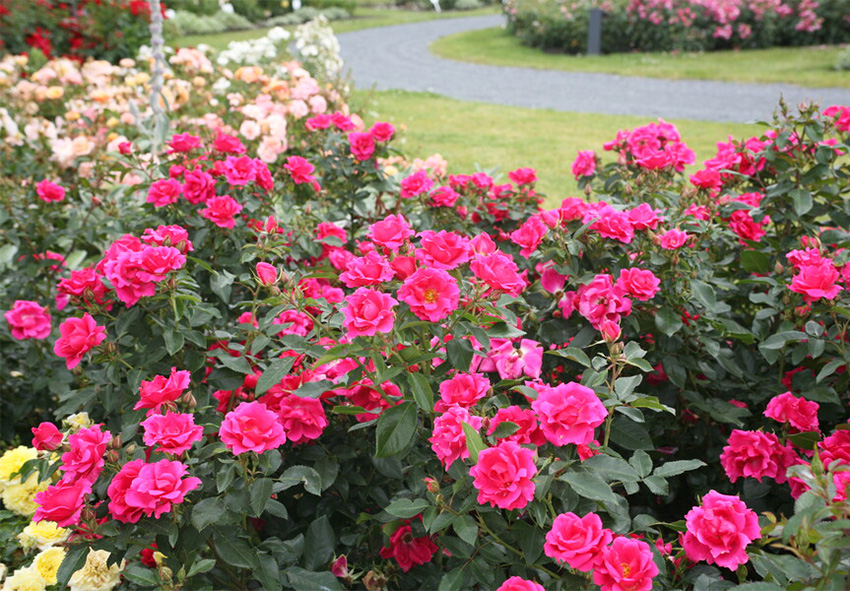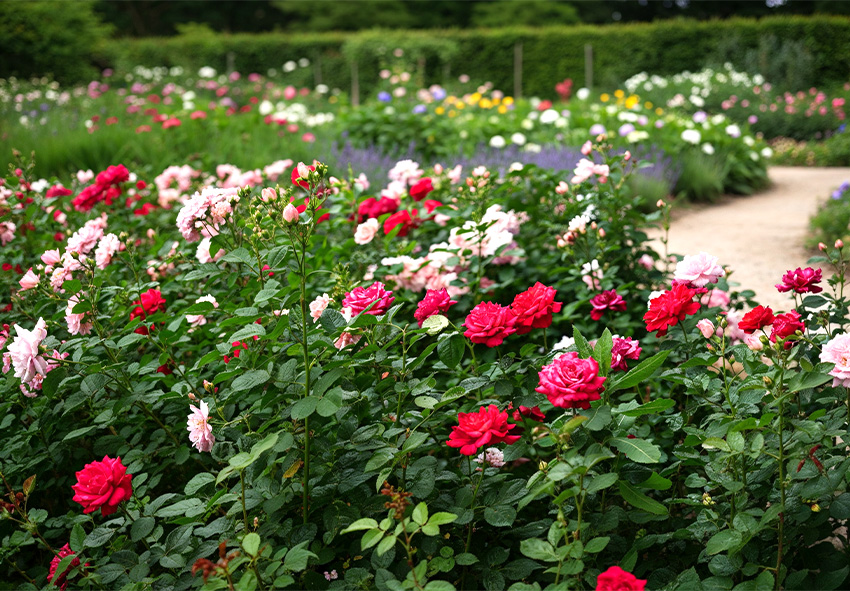Few plants bring as much romance, color, and elegance to a garden as roses. Known for their timeless charm, roses are perfect for creating both classic and contemporary landscapes. With careful planning and creative combinations, you can design a rose garden that enhances your outdoor space and delights the senses all season long. Our gardening blog is a perfect place to find all the information you need!
Why Include Roses in Garden Design?

Roses have captivated gardeners for centuries, offering a unique blend of beauty, fragrance, and versatility. Incorporating roses in garden design adds texture, structure, and color depth to any space whether you prefer an elegant formal look or a relaxed cottage vibe. Beyond their beauty, roses also attract pollinators and thrive in a variety of settings.
The Timeless Appeal of Roses
Roses are often called the “queen of flowers” for good reason. Their blooms come in countless shapes and shades, from soft blush tones to dramatic reds and purples. When thoughtfully placed in a garden, roses create an atmosphere of sophistication and warmth that never goes out of style.
Benefits of Growing Roses in the Landscape
Besides their aesthetic value, roses offer practical advantages. They provide long blooming periods, enhance garden structure, and attract beneficial insects like bees. Certain rose varieties are even drought-tolerant and can serve as hardy anchors in mixed borders or hedges.
Choosing the Right Roses for Your Garden Style
Choosing roses that match your garden’s design style is the first step to a cohesive landscape. Whether your taste leans toward traditional, romantic, or modern, there’s a rose variety to suit every aesthetic.
Classic Rose Gardens
Classic rose gardens often feature symmetry, order, and elegance. Hybrid tea and floribunda roses work beautifully in formal designs, arranged in geometric beds bordered by low boxwood hedges. Add gravel paths or a fountain for a timeless European feel.
Cottage-Style Gardens
If you love a softer, more natural look, cottage-style gardens are ideal. Combine shrub roses or David Austin English roses with perennials like lavender, delphinium, and foxglove. The mix of colors and textures creates a charming, storybook atmosphere that feels both lush and inviting.
Modern and Minimalist Gardens
For contemporary spaces, simplicity is key. Choose compact rose varieties in bold, uniform colors such as white, coral, or deep red. Plant them in clean lines or raised beds with gravel or ornamental grass borders for a sleek, minimalist aesthetic.
Color Combinations and Themes
The color palette of your rose garden sets its mood. Whether you prefer soothing pastels or bold, dramatic hues, thoughtful combinations will enhance your overall garden design:
- Romantic Pastels: Soft pinks, creams, and blush tones evoke a classic, romantic feel. Combine varieties like ‘Evelyn,’ ‘Heritage,’ and ‘Queen of Sweden’ for a harmonious, dreamy effect. Add white flowering perennials to highlight their subtle beauty.
- Bold and Dramatic Palettes: For a more striking display, use deep reds, purples, and dark oranges. Pair varieties like ‘Black Baccara,’ ‘Munstead Wood,’ or ‘Falstaff’ with contrasting greenery or silver foliage for an exotic, moody garden.
- Monochromatic Rose Designs: A single-color rose garden looks elegant and modern. Plant all-white varieties for a serene, minimalist space, or go with all-red roses for a passionate, dramatic statement.
Design Ideas for Using Roses

Roses can serve as centerpieces, background anchors, or natural dividers in your landscape. Their versatility allows you to play with color, height, and texture for endless design possibilities.
Roses as Focal Points
A single rose bush or a group of vibrant varieties can instantly draw attention. Plant statement roses like ‘Queen Elizabeth’ or ‘Double Delight’ near entrances, patios, or along pathways to create natural focal points that anchor your design.
Mixed Borders and Companion Planting
Pair roses with companion plants that enhance both appearance and health. Perennials such as lavender, sage, and catmint not only add fragrance and texture but also deter pests naturally. Mixing colors and leaf shapes prevents monotony and highlights each plant’s beauty.
Climbing Roses and Arches
Climbing roses are perfect for adding vertical drama. Train varieties like ‘New Dawn’ or ‘Eden Rose’ on pergolas, fences, or arches to frame entrances and create stunning walkways. They bring romance and height to garden spaces that might otherwise feel flat.
Planning the Perfect Rose Garden Layout
A successful rose garden layout balances aesthetics and practicality. Start by evaluating your garden’s light, space, and soil to determine where your roses will thrive best.
Site Selection and Sunlight Needs
Roses love sunlight at least 6 hours of direct light per day ensures vibrant blooms and healthy growth. Choose an open area with good airflow to prevent fungal diseases. Avoid spots with heavy shade or waterlogged soil.
Spacing and Arrangement
Proper spacing helps roses develop strong roots and reduces the risk of disease. Leave enough room between plants about 45–60 cm for most shrub roses and arrange them by height and color to create visual harmony across your garden.
Roses in Containers and Small Spaces
Even without a large yard, you can still enjoy roses by growing them in containers. Potted roses are perfect for patios, balconies, and small courtyards.
Container Rose Varieties
Look for compact or patio rose varieties such as ‘Sweet Dream,’ ‘The Fairy,’ or miniature roses. These small but resilient types bloom generously and are easy to maintain in pots.
Design Tips for Pots and Planters
Use large containers with good drainage and pair your roses with complementary trailing plants like lobelia or ivy. Match pot materials terracotta, ceramic, or metal to your overall garden style for a cohesive design.
Inspiring Rose Garden Combinations

Combining roses with other plants can elevate your garden design and make maintenance easier. Strategic pairings create year-round interest, even when roses aren’t in bloom:
- Roses with Lavender and Catmint: This classic pairing blends fragrance, color, and form. Lavender’s silvery foliage and purple flowers perfectly complement the soft tones of pink or white roses.
- Roses with Ornamental Grasses: For a modern twist, mix roses with airy grasses like fountain grass or stipa. Their movement contrasts beautifully with the structured rose blooms.
- Roses with Evergreen Shrubs: Evergreens such as boxwood or yew provide year-round structure and a lush green backdrop that highlights the vivid colors of your roses.
Maintenance Tips for Lasting Beauty
Regular care for roses keeps your flowers vibrant and productive. Simple practices like pruning, feeding, and mulching ensure your plants stay healthy year after year.
Pruning and Deadheading
Prune in late winter or early spring to remove dead or weak stems. Deadhead faded blooms throughout the season to encourage continuous flowering and neat growth.
Feeding and Watering
Feed roses with a balanced fertilizer rich in potassium and phosphorus during the growing season. Water deeply once or twice a week, allowing the soil to dry slightly between watering to prevent root rot.
Conclusion
Designing a rose garden is both an art and a pleasure. By choosing the right varieties, colors, and companions, you can create a space that’s uniquely yours, timeless, fragrant, and full of life. Whether your garden is grand or compact, roses bring unmatched beauty and elegance to every landscape!
Frequently Asked Questions (FAQs) about Roses in Garden Design
1. What are the best roses to use in garden design?
Hybrid tea roses, floribunda, and English shrub roses are popular choices for garden design. They provide long-lasting blooms, a range of colors, and strong fragrances. Climbing roses like ‘New Dawn’ or ‘Eden Rose’ are perfect for arches, trellises, and vertical accents in the landscape.
2. How can I design a small garden with roses?
For small spaces, choose compact or patio rose varieties that thrive in containers or small beds. Arrange them in groups for color impact and combine them with low-growing plants like lavender or catmint. Container gardening allows flexibility and makes it easy to move roses for better sunlight exposure.
3. What colors work best in a rose garden layout?
It depends on the style you want to achieve. Soft pastels create a romantic and classic look, while deep reds, purples, and oranges give a dramatic effect. For a modern design, use monochromatic color schemes such as all-white or all-red roses for bold visual unity.
4. How can I order Holland roses from your online store?
Ordering roses from our online store Dutch-bulbs.com is simple and convenient. Visit our website and browse our selection of rose varieties, including those sourced from Holland. Once your order is confirmed, our team will carefully pack your Holland rose bulbs, ensuring they arrive fresh and ready for planting.
5. Can roses be combined with other plants in garden design?
Yes! Roses pair beautifully with many perennials and shrubs. Companion plants like lavender, sage, salvia, and ornamental grasses enhance visual appeal and deter pests. Mixing roses with evergreens also ensures your garden remains structured and attractive even when the roses are not in bloom.
Published: 18.11.2025
